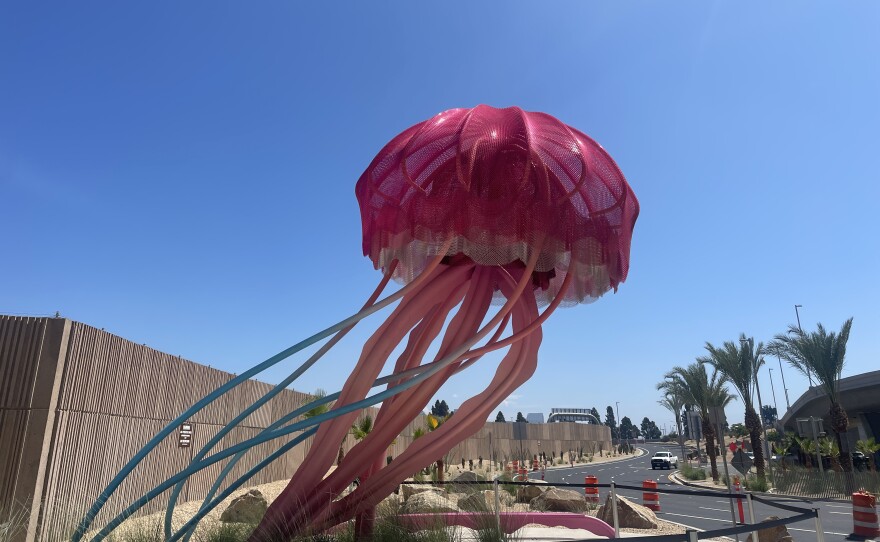When driving up to the departure gates at San Diego International Airport's new Terminal 1, the first thing travelers might notice is art.
Two new sculptures flank the approach — including a gigantic, hot pink jellyfish welcoming passengers. Artist Matthew Mazzotta's "RISE" sculpture is based on a type of sea creature that dwells in the region's coastal waters, the purple-striped jelly.
Mazzotta, who visits his family in San Diego often, said he thought about what an airport can provide a community.
"For me, I travel all the time. So an airport is obviously — it's like a culmination of society's best," Mazzotta said. "An airport is always about identity. When you land in a place, does it feel good? Is it welcoming?"
The jellyfish is made of painted stainless steel and an architectural mesh known as Kaynemaile. The material was developed by Kayne Horsham, armor, weapons and creatures art director for the "Lord of the Rings" movie trilogy. After creating an ultralight chainmail for the Middle-earth characters, Horsham realized the material could have architectural uses.
For "RISE," the chainmail is a flowy, vivid fuchsia, sparkling in the sun and illuminated at night. In the shadow of the jellyfish is a small stage area intended for performances.

Mazzotta said the sculpture is intended to warn about rising sea levels and climate change.
"It's about sustainability, the footprint, the whole thing. In this case, it's called 'RISE' because if we don't pay attention to it, at one point there might be a jellyfish where this jellyfish is," he said.
An airport may seem like an unusual place to find art, but Aleta Lee, public art program manager for the airport, said it makes sense.
"Sometimes the airport can be a really stressful environment, and art provides a way of entertainment in terms of maybe a distraction or a way to get your mind off things," she said. "Also, it can be used as a way of wayfinding or being a landmark."

As travelers line up for security, a glance upward reveals a suspended structure, made of more than 900 reflective golden pieces: Nova Jiang's "Torrey Pines," inspired by the rare tree species and its importance to the region
"Apparently a lot of the indigenous people of the San Diego region used the Torrey pines for a lot of its different benefits, not only getting food from it, but using parts of its branches and needles to do sewing and just really being able to use it as a resource," Lee said.
While none of the major artworks were created by local artists, local sculptor Kaori Fukuyama worked with Jiang on "Torrey Pines" in a public art apprenticeship role.

Other new works include a pair of red and yellow mythical bird-inspired outdoor sculptures (Walter J. Hood's "Migrations"), a sound-responsive LED light fixture (Erwin Redl's "Vessel of Light"), and a series of mosaic columns capturing the transition from sunrise to sunset using a million individual tiles (Amy Ellingson's "A Day in the Sun").
Two pieces, Christie Beniston's 2009 "Time Interwoven" and Charles R. Faust's 1966 "Sandcast," were relocated from the old terminal.
One artistic installation is actually part of the building's architectural design: James Carpenter's curved, ribbed windows that serve as the main wall of the terminal's ticketing area.
"I really hope that passengers just get a taste of what San Diego has to offer and what's represented in this artwork, but also come feeling a little bit more joyful about their experience at the airport," Lee said.
San Diego International Airport has a robust art program with two main endeavors: permanent public art from worldwide talent and temporary exhibitions featuring local artists and thematic installations throughout the airport.
Currently, the new Terminal 1 has eight works of public art plus a gallery space. Temporary exhibits will eventually pepper the gates and fill the gallery.
I think that cities have figured out that if you invest in public art, it makes the whole thing better.Matthew Mazzotta, artist
Public art in the new terminal had a price tag of $10 million for commissioning, installation, plus a future phase. The new terminal's construction budget overall is approximately $3.8 billion.
In addition to this one-time allocation for Terminal 1, the airport annually spends about $200,000 to $300,000 directly on art and artists, said Tiffany Beres, who manages the entire arts program at SAN.
"We spend about this same amount on just the creative sector — jobs that are peripherally related, like installers, conservators, sound experts. So all of that together, we definitely have a good impact in terms of our contribution to the creative economy here," Beres said.

Not flying anytime soon? The airport plans to extend its "gate pass" program to Terminal 1, where visitors can apply in advance for approval to go through security without a boarding pass.
For Mazzotta, he hopes the art ultimately improves the traveling experience — and the place itself.
"I think that cities have figured out that if you invest in public art, it makes the whole thing better," he said. "It is a very efficient way to give people a touch point that brings identity, it brings joy. It's like wayfinding, landmarks, the whole thing."







